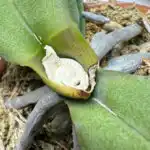Some of the links in this post may be affiliate links.
I’ve been asked by so many people how to properly care for orchids and get them to re-bloom. There is a common misconception that they are difficult to grow. Contrary to what many people think, they are tough as nails and orchid care is simple once you know what they like! Let me show you how REALLY to grow these plants. You may be shocked at what you’ll discover!

Table of Contents
HOW TO CARE FOR PHALAENOPSIS ORCHID PLANT
Most people are familiar with the ubiquitous Phalaenopsis orchid, or “moth orchid.” They come in a huge variety of colors. Phalaenopsis orchids are available everywhere these days: grocery stores, Home Depot, Lowes, etc.
If you are just beginning with orchids, I would recommend starting with a moth orchid. When most people think of an orchid, this is the one that pops into their head, but there are literally hundreds of orchid genera and THOUSANDS of orchid species, and an even larger number of cultivars.
Did you know vanilla comes from an orchid?

1. What NOT To Do With Your Moth Orchid
First off, please do not water your orchids with ice.
The majority of orchids come from tropical and subtropical areas of the Earth, and they have never met an ice cube or icicle in their lifetime. The ice can damage the roots if in direct contact, and you won’t get a good soaking of the potting medium with just 3 ice cubes.
You’ll likely get dry, dead zones in the potting media and not achieve a consistent soaking. There actually are orchids that are native to areas that freeze (including Ohio!) but not the ones that you commonly see at the store, and definitely not moth orchids.
Orchids are among the largest plant families on Earth and there are varieties that are native to every continent except Antarctica.
But for moth orchids and other exotic orchids that you’ll see…just say NO to the ice cubes. I’ll describe how I water my orchids later on in this post. Keep reading.

2. Picking Your First Moth Orchid
When you pick your first Moth Orchid, try and choose one that doesn’t have all the buds open. This will ensure that the flowers will last longer. If all the flowers have opened, you have no idea how long they’ve been open.
I grow many kinds of orchids, but one of the reasons I love moth orchids is that one plant can easily bloom for a good 3-5 months! They can quickly become an obsession.

When you take your orchid home, I like to place it on display anywhere inside the house. After it’s done blooming, I will return the plant to its permanent home by the window.
For a display area though, just pick an area that isn’t in any sunshine or too much heat (or too cold! Keep it above 55 degrees…remember, they’re tropical).
If you want to learn all about how to get your orchid to rebloom reliably and have healthy, thriving moth orchid plants, don’t miss my signature, online orchid care course, Become an Orchid Master. It also includes bonuses with support from me, personally, to guide you in your orchid journey!
3. What To Do With Orchids After Blooming
When it is done blooming, you can do one of three things.
Method #1
If the flower stalk is still green, you can leave it. It may continue to flower and grow at the tip. It may also branch off and grow new flowers.
Method #2
If you notice that the tip of the flower stalk starts to yellow or brown, you can also cut the flowering stalk off one or two nodes below where the bottom flower was, and sometimes they will start branching off and grow new buds.
You’ll want to cut right above the node or little bump that you’ll see on the stalk.
Method #3
If and when the whole flower stalk is turning yellow or brown, simply cut off the entire flower stalk. Your orchid will rebloom in due time.
Check out my YouTube video on this topic below to visually see how to do this!

For more details and photos, check out my post on what to do with orchids after blooming.
4. What Window is Best For Orchids?
I find that eastern exposure windows are great for moth orchids! They are great for many types of orchids…Place it pretty close to the window, without touching the actual glass.
The light intensity drops dramatically as you get further from the window. You can grow moth orchids in other exposures such as west or south, but you should shield them from too much sun otherwise they can potentially burn.
Either draw your blinds or a sheer curtain. Filtered bright light works great.
5. Watering and Fertilizing Your Orchid
This is where most people don’t know what to do. Let’s learn now how to care for an orchid with proper watering and fertilization.
In most indoor environments, watering your moth orchid once a week is sufficient for orchids growing in bark. Consistency is key! I take my orchids to the sink every weekend and give them a good soaking in the sink. Use tepid water.
For Phalaenopsis orchids growing in sphagnum moss, feel the surface of the moss and water when the surface feels completely dry. Do not let all of the moss go completely dry.

REALLY SOAK THE HECK OUT OF THEM! Moth orchids, like many types of orchids, are epiphytes. Epiphytes grow above ground, derive their moisture from the air and rain, and usually grow on another plant, such as a tree branch or trunk.
Another method to water your moth orchid is the following. Place your orchid into a pot that has no drainage hole, and fill it with water.
Let your orchid sit for 15-30 minutes, then slip the plant out of the decorative pot and discard the extra water.
If you look carefully, you’ll notice that moth orchids do not grow in potting soil! You will kill a moth orchid if you repot it into potting soil. They need a highly aerated mix. They are most commonly grown in a chunky bark mix or in sphagnum moss.
If your pot looks really dry, soak it first with plain, tepid water. Then water it with a diluted fertilizer. A good rule on fertilizing is “weakly, weekly!”
You can use many different types of fertilizer. Right now I am using Dyna Gro Grow fertilizer (link to Amazon) for my orchids, and also for most of my other indoor plants.
It is a fabulous, high quality fertilizer. I add 1/4 teaspoon per gallon of water and use that every time I water.
Check out the following YouTube video that I created showing how to water moth orchids.
6. Getting Your Moth Orchid to Rebloom
Your moth orchid should rebloom once a year, and like I mentioned, the bloom period will be 3-5 months! Occasionally you might get a stubborn orchid (they are just like people!) and it won’t rebloom faithfully every year.
The blooming may be more sporadic. Don’t give up. My solution is to buy more orchids and grow your collection until you get more confidence.
There is a trick though to get stubborn orchids to rebloom so keep reading!

Summering your orchid outside does WONDERS for orchids or any plant. This is when your moth orchid should grow a leaf or two. It may not seem like a lot, but the leaves are huge.
Again, just make sure that it never sits in any water for any period of time or it will rot. Keep it in a very shady spot outdoors.
Wait until the night time temperatures are consistently a minimum of 50-55 degrees Fahrenheit before even thinking of putting it outdoors. If in doubt, wait!
Here is a secret that you may not have known in how to get your orchid to bloom.
A drop in night-time temperatures of 10-15 degrees or more between day and night temperatures will help trigger your orchid to re-bloom.
Keep your orchid outside until late summer/fall and bring them inside when the nighttime temperatures start to dip below the 50s. Bring them in before they go below 50 though. Then return to its normal window.
This drop in temperature outside should be enough to start a new bloom spike to grow in the fall/winter and should bloom in the winter/spring.
Some of them will choose to bloom whenever the hell they want though so don’t be shocked if they bloom during another period!
7. How to Repot an Orchid
Check out my YouTube video on how to repot an orchid. It contains everything you need to know.

Lastly, check out my short eBook, Moth Orchid Mastery, which was a #1 New Release on Amazon. My tips have helped countless readers have confidence with growing moth orchids, and I’m confident that
That’s it for now! Orchid care really isn’t complication, and this should be enough to get you started. And beware, because it may become an obsession…







Sandy
Saturday 23rd of November 2024
Thank you so much for this information. I’ve tried growing orchids in the past with no success. Basically I didn’t know how or when to water them. Now I have two moth orchids. One has a keiki and 2 bloom spikes, with another bloom coming from below the keiki… The other orchid has only one spike but, I’ve had it for several years and it’ll be exciting because I don’t know what color bloom it will be…
Sandy
Saturday 23rd of November 2024
I’m sorry I neglected to say my current success is due to following the advice on this website….
Thank you very much
Raffaele Di Lallo
Saturday 23rd of November 2024
Hi Sandy! Well it sounds like you are doing something right! :-)
Isabel
Saturday 9th of November 2024
I am trying to save this orchid for a friend. It cam to me in a pot full of water. I repotted with new orchid bark soil and I’m watering once a week. There is something growing. But I’m not sure it can be saved. Any suggestions?
Cheryl
Tuesday 12th of March 2024
Thank you for the very helpful info! Would you, at some point, speak about the new videos n YouTube advocating watering your orchids with rice water, garlic water and aloe Vera water?
Raffaele Di Lallo
Wednesday 13th of March 2024
You're very welcome Cheryl! Tell me about your experiences with rice water, garlic water and aloe vera water? I haven't personally tried that myself, and I'm curious about your results!
Mallie
Saturday 18th of December 2021
This is amazing. Thank you. I love orchids, but gave up on owning because I thought I was killing them. Now I’ve gotten one for myself and a neighbor and now when mine stops flowering, instead of getting rid of it, I will follow your advice. Thank you.
Raffaele
Saturday 18th of December 2021
Glad you enjoyed the post Mallie! Good luck with your orchid. Once you get used to them, they're not that bad! Just a little different from other plants.
yonatan
Tuesday 19th of October 2021
how to deal with keikees ?
Raffaele
Tuesday 19th of October 2021
I would leave them on the plant until they grow their own roots, and then you can cut them off and pot them up :-).